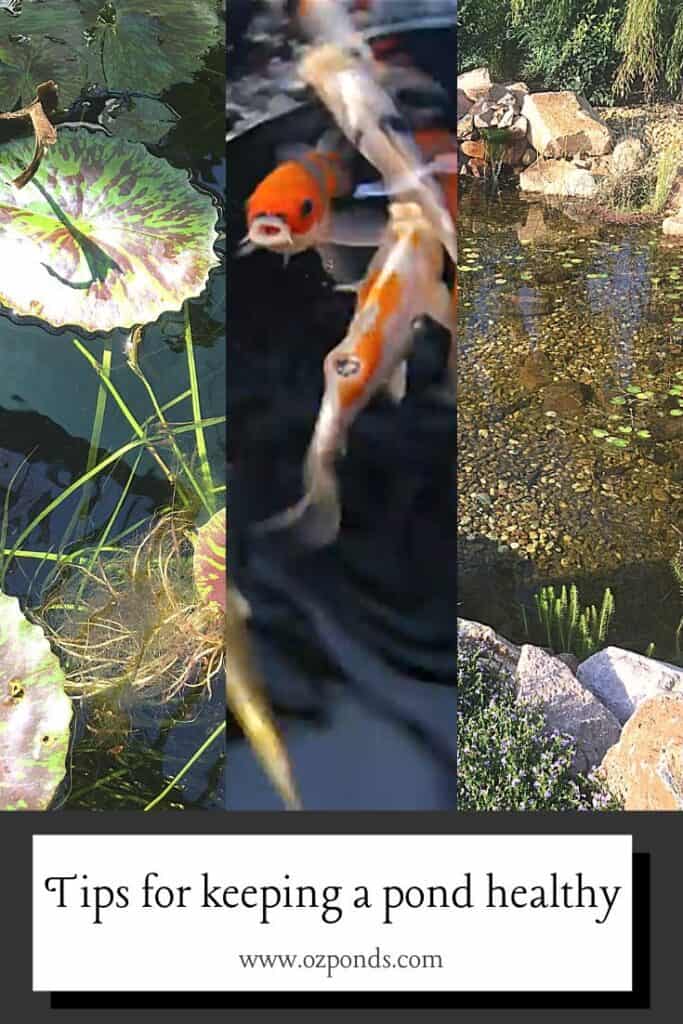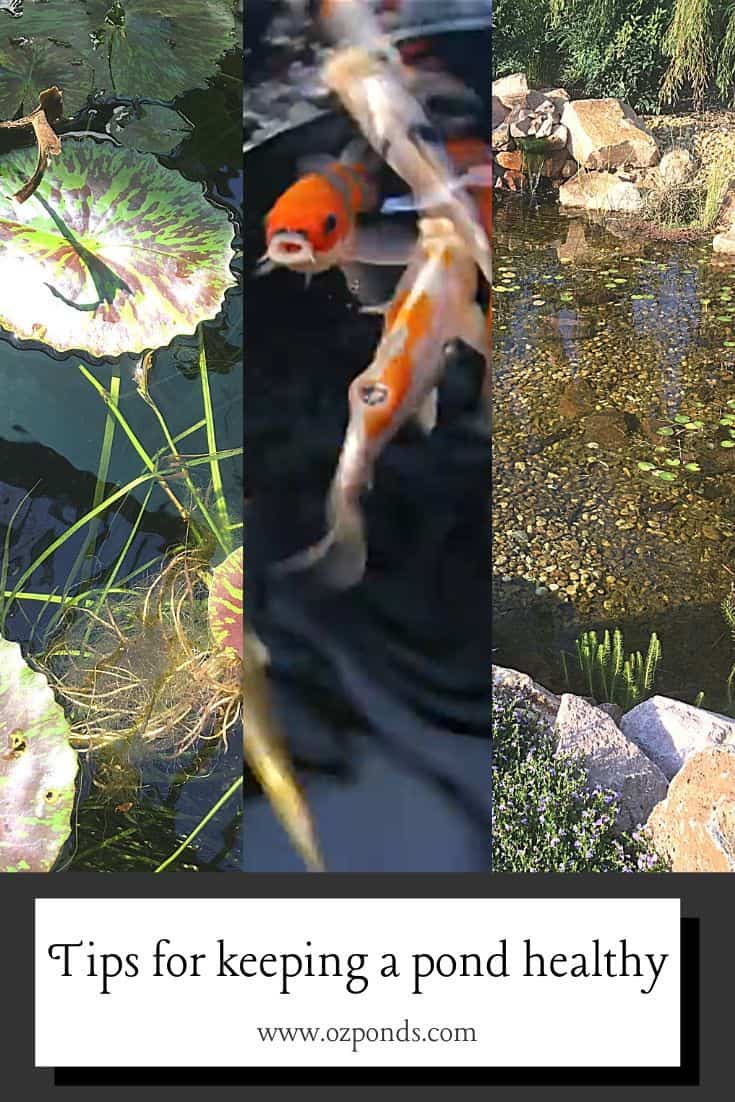Maintaining a healthy fish pond is actually very, very easy. The trick is to work in balance with the environment not against it.
The nitrogen cycle is the main driver of a healthy fish pond!
The most important factor is whats called the nitrogen cycle!
This cycle is completely natural and will allow fish to thrive in the pond.
Not only will a healthy nitrogen cycle keep your fish happy, it will also provide crystal clear water and very little maintenance. This cycle is the backbone of creating a well balanced ecosystem within the pond.
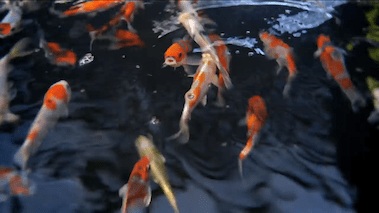
What’s is the nitrogen cycle?
The nitrogen cycle is a circle of life.
Without a well established nitrogen cycle your pond fish will become sick and most likely die.
In a pond environment it works by taking the ammonia and processing it it to less harmful compounds.
Most of the ammonia in the pond will be produced by the fish (mostly through breathing).
Decaying plant material will also release ammonia as it breaks down.
Ammonia is toxic to fish and even small levels can kill fish!!

Luckily the bacteria that will colonise a pond will convert the ammonia that is produced into nitrite.
This is still quite harmful for the fish and other aquatic life. We don’t want it present in the pond.
The final step in the cycle is the nitrite being processed into nitrate.
This is far less harmful for our fish and can be quite safe, in small doses.
An API test kit is what i use to test the levels of ammonia, nitrite and nitrate in my ponds.
We want ammonia and nitrite at 0ppm (parts per million) and nitrate under 40ppm.
Test kits can be purchased on-line. API test kit on eBay– click to check price.
API test kit on amazon– click to check price.
The whole nitrogen cycle process occurs due to the presence of beneficial bacteria.
Beneficial bacteria are the workhorse of the entire pond and their health and well being is critical!
You can read more information about the nitrogen cycle in a pond here.
Providing a home for the bacteria.
So to have a nice healthy nitrogen cycle we need bacteria!
The more the merrier.
Nitrifying bacteria are easy to provide for, all they need is surface area.
Surface area, what do you mean?
The little bacterias will grow on any surfaces that are kept constantly wet.
Rocks and pebbles within the pond will greatly amplify the amount of surface area available for the bacterias to colonise.
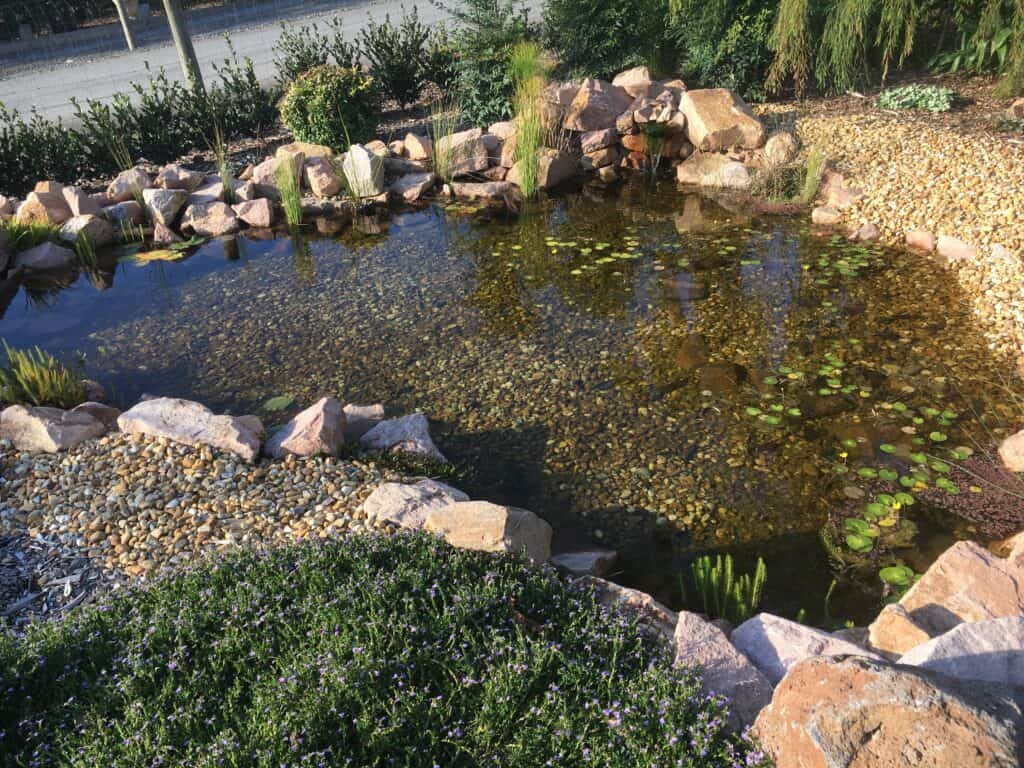
They will still grow in ponds with bare liner or container ponds, just not in large enough numbers.
Simply because in these ponds there is less surface area!
So the easiest first step to provide a home for beneficial pond bacteria is adding rocks and pebbles.
I know some people fear adding rocks and pebbles to a pond. They think it will make the pond harder to clean.
But i tell you if you have a thriving colony of bacterias and other micro-organisms living on the rocks and gravel, pond maintenance can become a thing of the past.
Bog and wetland filters
For me these the best filters you can add to any pond!
A bog or wetland filter works by incorporating rocks, pebbles and plants to produce a perfect little ecosystem for keeping fish ponds clean and healthy.
The rocks and pebbles provide the extra surface area for the bacterias to grow on while the plants remove the nutrients from the water.
It’s so simple and so natural!
If you would like to read more about bog and wetland filters read my article on the topic.
Below is a short video showing a small fish pond i built. Originally it had no bog filter and the water quality was poor.
A few weeks after adding the bog filter the water was crystal clear!
At the time of writing this article the pond is 2 years old, the water is still crystal clear and i do no maintenance whatsoever.
I’m telling you bog filters work wonders!
And why wouldn’t they?
A bog filter provides the perfect environment for the nitrogen cycle to thrive!
Keeping the bacteria safe.
The number 1 killer of beneficial bacteria is chlorine!
Our tap water is treated with chlorine to kill bacteria living in the water and the pipes, that deliver water to our houses.
This removes any nasty bacterias that can make us sick but it also kills the good bacterias that keep a fish pond healthy.
Without the nitrifying bacteria there will be no nitrogen cycle.
With no nitrogen cycle the ammonia produced will get to dangerous levels.
So the number 1 rule is never add chlorinated (tap) water into an existing pond with fish!
When you first construct a pond you can use tap water to fill it as there is no bacteria living there yet.
There are 2 ways we can treat tap water:
- Using a de-chlorinator. There are many available and they all do the same thing they remove the chlorine from the water. Most of them offer other benefits but all we really care about is removing the chlorine.
- Allowing the water to sit. If we can allow the water to sit in a trough or similar for 48hrs the chlorine will evaporate away. The water is then safe for the good bacteria living in the pond.
If you have access to tank water this is easily the best option for topping up you’re fish pond.
Pond circulation
Having adequate pond circulation will ensured that as much water as possible is processed by the bacteria.
As the water is passed over the surfaces where the bacteria live they will do their thing.
As a general rule of thumb the water in a fish pond must be circulated once every hour.
This is the minimum!
I have written an article on selecting the right pond pump if you want to check it out.
Circulating more frequently will improve overall filtration performance and thus water quality.
The best way to achieve optimal pond circulation is to place the pump in a skimmer box (as pictured).
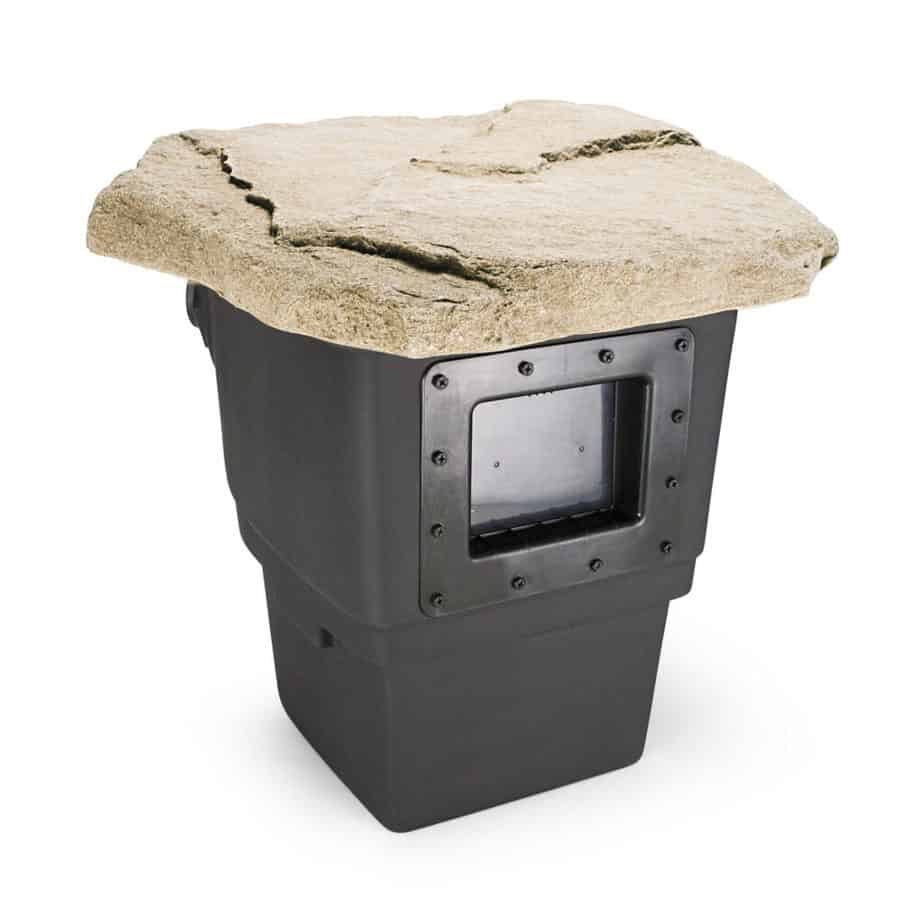
A skimmer is fantastic at removing floating debris like leaves. Removing this from the pond greatly reduces the amount of work the bacteria or you need to do!
From the skimmer box take the pipe work to the bog/ wetland or other biological filter.
This forces all the water through as much nitrifying bacteria as possible before it returns to the pond.
The digram below show the aquascape model of pond construction. This is a great model to follow as it provides excellent pond circulation.

Aquascape provides pond kits that come with everything needed to create a perfect ecosystem fish pond.
This link will show you the cost of an aquascape pond kit on eBay.
Or if you prefer amazon check out this link for aquascape pond kits.
Over feeding the fish
Now that we understand the vital importance of bacteria within the pond ecosystem, let’s address fish feeding.
Feeding fish can be one of the most enjoyable aspects of owning a pond. I personally love checking on my fish everyday! Morning and night.
When we love our fish so much it’s so easy to overfeed them. Fish aren’t stupid they know who we are and basically beg us for food.
But don’t kill your fish with kindness! Overfeeding fish is bad for the fish but even worse for the water quality.
Overfed fish will not forage and hunt for food.
It’s important that they maintain these healthy habits. Just as exercise is important for us, this is a form of exercise for your fish.
Only ever feed what your fish can consume in 2 minutes.
If uneaten food is left in the pond it will put added pressure on your beneficial bacteria to process the waste.
A pinch of uneaten food one day may not seem like much but over time the accumulative effect can be disastrous for the balance of the pond.
Over feeding will also leads to algae outbreaks, most often green pond water. This is caused by the excessive nutrients being produced as the bacteria struggles to process all the food.
The algae is there to feed on the excess nutrients in this case nitrate. Remember that nitrate levels above 40ppm are detrimental to fish health.
The algae is natures way of keeping the pond water healthy for the fish.
If you experience green water stop feeding the fish for a few weeks. Hopefully the beneficial bacteria and pond plants will bring the pond system back into a healthy balance, without the need of algae.
Winter feeding?
Another tip with feeding is not to feed when the weather is cold. As a general rule if you think its cold out, so do your fish!
During the winter or even cold snaps your fishes metabolism slows right down. With a slow metabolism their bodies cannot process as much food.
I simply don’t feed them at all! if they are hungry they can nibble on some algae, pond plants or insects.
Quality fish food
With fish food protein is key! much like a muscle building diet. The food that your feeding the pond fish should have at minimum between 35-40% protein.
Now this protein should come from fish meal! Quite often cheaper foods will bulk up the protein content using cornmeal. This is much harder for fish to digest and can lead to health problems.
Fish need live foods. You can purchase live food for your fish if they are large predatory fish. However for simple pond fish such as goldfish this is unnecessary.
Fish will basically eat anything that fits in their mouth. And if you’ve created a well balanced ecosystem within your pond as suggested in this article, there will be plenty of living animals and insects within the pond.
Your fish will eat some of these. It’s the circle of life.
Contaminants that may affect fish pond water health
Pond liner
Sometimes in an effort to cut costs people will purchase a cheap pond liner or even use totally unsuitable liners like builders plastic.
Cheap plastics will leach chemicals into your pond water that will kill fish! This often happens as the plastic liner breaks down. Common causes of plastic degradation are UV exposure and organic gases in the soil.
If your going to the trouble and expense of building a pond do it properly! The best pond liner is EPDM! Cheaper fish safe options are HDPE and PVC. For more info on them check out the article on selecting a pond liner.
Silicon
Another possible contaminant is using the wrong silicon on your pond project. This is not as common but still something to be aware of.
There are numerous kinds of silicon. If using silicon on your pond, say sealing a skimmer box to the pond liner, make sure it’s fish safe!
The easiest way to do this is ask the hardware store attendant for aquarium silicon or check that on the label it specifically states “for aquarium use”.
Like using the wrong pond liner the wrong silicon can deteriorate and leach harmful chemicals into the water.
Runoff
It’s always best practice to keep storm runoff out of a fish pond. Stormwater runoff is rich in nutrients and can lead to algae blooms.
Algae blooms are not really a health risk to your pond fish. As i mentioned earlier its just natures way of balancing excess nutrients.
However storm runoff can easily pick up other toxins and deposit them into your pond.
Oil on the road, pesticides & herbicides are just some of the contaminants that can be in runoff. All are harmful to your fish and bacteria.
Use berms or trenches to keep runoff out of your pond!
Summary
So the single most important thing in creating a fish safe pond is the beneficial bacteria that will convert the harmful ammonia into safer nitrate.
If the nitrate levels get to high it won’t be detrimental to the fish as algae will grow and consume the nitrate.
Of course most of us find algae unattractive. So feed in moderation and don’t overstock your fish pond!
Follow these simple principles and you’ll always enjoy healthy clear water for you and your pond fish.
Subscribe
If you haven’t already be sure to subscribe to our mailing list. We often receive special discounts on pond equipment that we are more than happy to share with our loyal readers.
